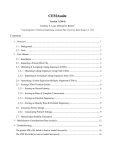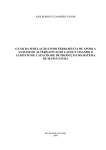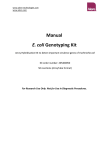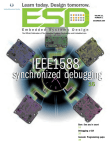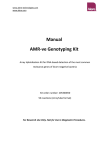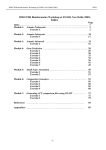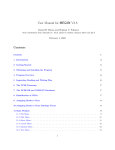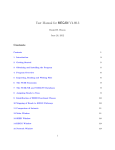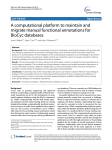Download tRNAcc 1.0 User Guide - db-MML
Transcript
tRNAcc 1.0 User Guide Version: 1.0 for Linux (Fedora Core 5) Last revision Date: 20/08/2005; 26/09/2005; 07/12/2005; 24/10/2006 Author: Hong-Yu Ou 1, Kumar Rajakumar 2 1. Laboratory of Molecular Microbiology, Shanghai Jiao Tong University, Shanghai 200030, P.R. China 2. Department of Clinical Microbiology, University Hospitals of Leicester NHS Trust, Leicester LE1 5WW, United Kingdom. All rights reserved by Laboratory of Molecular Microbiology, Shanghai Jiao Tong University, 1954 Huashan Road, Shanghai 200030, P.R. China, and Department of Infection, Immunity and Inflammation, Leicester Medical School, University of Leicester, Leicester LE1 9H, United Kingdom. E-mail: [email protected] (H.-Y. OU) [email protected] (K. RAJAKUMAR) 1 Table of contents 1. Disclaimer ....................................................................................................................................3 2. tRNAcc package ..........................................................................................................................3 3. Program (I): IdentifyIsland ..........................................................................................................9 4. Program (II): TabulateIsland......................................................................................................13 5. Program (III): ExtractFlank .......................................................................................................15 6. Program (IV): DNAnalyser........................................................................................................17 7. Program (V): GenomeSubstrator ...............................................................................................22 8. Program (VI): LocateHotspots...................................................................................................25 9. Application of tRNAcc to interrogate CGI-defined non-tRNA hotspots ..................................28 2 1. Disclaimer tRNAcc 1.0 is freely available to academic users for not-for-profit purposes provided that the original work is properly cited. However, no re-distribution is allowed without written permission of the authors. The program for the linux platform has been tested under Fedora Core 5. This program, however, is distributed without any warranty, without even the implied warranty of merchantability or fitness for any purpose. The responsibility for any adverse consequences from the use of the program or documents or any files created by use of the program lies solely with the users of the program and not with authors of the program. 2. tRNAcc package A software package called tRNAcc 1.0 is designed to facilitate the process of investigating the contents and contexts analysis of tRNA sites in multiple closely related bacterial genomes. It is described in: H.-Y. Ou, et al. (2005). A novel strategy for identification of genomic islands by comparative analysis of the contents and contexts of tRNA sites in closely related bacteria. Nucleic Acids Res., 34, e3. tRNAcc 1.0 comprises a suite of individual tools listed in Table 1. The software is divided into three sections by function: (I) Identification of the tRNA-associated GIs and their boundaries (II) Design of primers specific to conserved UF and DF regions, and (III) Analysis of putative islands for evidence of foreign origin. The open source codes written in C++, Perl or Bioperl modules were tested under Fedora Core 5 at http://fedora.redhat.com/. The following directory structure is set up by installing tRNAcc: tRNAcc/ tRNAcc/input_data tRNAcc/output_data tRNAcc/temp_data 3 In this user guide, we take the primary tRNAcc analysis for the four fully sequenced E. coli and Shigella genomes as an example (Fig. 1): E. coli K-12 MG1655 (Refseq accession number: NC_000913.2), uropathogenic E. coli CFT073 (NC_004431), enterohaemorrhagic E. coli O157:H7 EDL933 (NC_002655) and S. flexneri 2a Sf301 (NC_004337). The MG1655 genome is served as the reference template. Demonstrations of the inputs and outputs for the software are given in the subdirectory tRNAcc/input_data and tRNAcc/output_data, respectively. See the lists in Table 2. Table 1. Stand-alone tools developed and utilised for high throughput analyses of the contents and contexts of tRNA genes in bacterial genomes Software tool a Description Reference Identify putative islands based on conserved flanking blocks This work Island identification IdentifyIsland identified using the multiple aligner Mauve 1.2.2 (Darling, et al. 2004, Genome Res., 14, 1394-1403) TabulateIsland Tabulate the islands identified when analysing different subsets This work of genomes LocateHotspots Locate proposed hotspots in un-annotated chromosomal This work sequences using BLASTN-based searches Primer design ExtractFlank Generate multi-FASTA files containing the upstream or This work downstream flanking regions for the identified islands Primaclade Design conserved PCR primers for the upstream or downstream Gadberry, et al. 2005 flanking regions across multiple bacterial genomes being Bioinformatics, 21, compared. This program is available at 1263-1264 http://www.umsl.edu/services/kellogg/primaclade.html Island analysis DNAnalyser Calculate the GC content and dinucleotide bias of identified This work islands, and the negative cumulative GC profile of genomes GenomeSubstrator High throughput BLASTN-based comparison of CDS sequences This work against test genomes to identify strain-specific CDS based on the level of nucleotide similarity a These programs can also be used for the generic identification and preliminary characterization of putative genomic islands located at other user-specified hotspots and for the analysis of cognate flanking sequences. 4 Genome sequences being compared (Reference genome: MG1655) 87 tRNA Set 4 Set 3I Set 3II Set 3III MG1655, CFT073, EDL933, Sf301 MG1655, CFT073, EDL933 MG1655, EDL933, Sf301 MG1655, CFT073, Sf301 IdentifyIsland List of MG1655 tRNA genes 65 tRNA Find tRNA genes conserved across all 4 genomes Extract 4-kb UCB and 250-kb DCB for individual tRNA gene in each genome Find conserved regions in UCB and DCB by using multiple sequence aligner Mauve Identify the tRNA gene-borne GI in each genome 4 3I Candidate islands based on Set 4 Candidate islands based on Set 3I 3II 3III Candidate islands based on Set 3II Candidate islands based on Set 3III Examine candidate islands with the aid of TabulateIsland 34 tRNA Retain GI > 1kb 25 tRNA Exclude tRNA sites falsely identified as bearing GI because of closely clustered tRNA genes 19 tRNA Examine GI using coliBASE assigned differing sizes depending on the genome subset analysed. Select the appropriate GI size. Final list and selected boundaries of tRNAassociated islands Make multi-FASTA files containing the 2-kb UF and DF regions for each tRNA gene using ExtractFlank Design primer pairs for each tRNA gene based on consensus regions using Primaclade Screen island-occupied tRNA sites in test strains using in vitro tRIP 5 Reject falsely selected GI 18 tRNA 1 tRNA Figure 1. Flowchart depicting the high-throughput strategy developed and utilised to analyse the contents and contexts of tRNA genes in the four sequenced Escherichia coli and Shigella genomes. The method was termed tRNAcc. Four stand-alone tools, indicated in bold italic font in the figure, were employed to identify islands (IdentifyIsland, TabulateIsland) and design primers (ExtractFlank, Primaclade) corresponding to the conserved upstream downstream flanking regions of each tRNA site to be interrogated. See Table 1 for a summary of the program features. In this study four complete genomes were compared by the tRNAcc method: E. coli K-12 MG1655, E. coli UPEC CFT073, E. coli O157:H7 EDL933 and Shigella flexneri 2a Sf301. Four distinct genome subsets were analysed with the MG1655 genome being used as the reference template in each case. The following abbreviations were used: UCB, upstream chromosomal block; DCB, downstream chromosomal block; GI, genomic island; UF, 2-kb upstream conserved flank; DF, 2-kb downstream conserved flank. 6 Table 2. List of the important files used in the tRNAcc analysis for the four Escherichia coli and Shigella genomes: E. coli K-12 MG1655 (NCBI Refseq AC: NC_00913), E. coli UPEC CFT073 (NC_004431), E. coli O157:H7 EDL933 (NC_002655) and S. flexneri 2a Sf301 (NC_004337) File type Directory File Comment Program tRNAcc/ Predefined script file See Table 1 for the stand-alone program in the tRNAcc software package Essential input files * tRNAcc/input_data Run_IdentifyIsland Run_TabulateIsland Run_ExtractFlank Run_DNAnalyser Run_GenomeSubstrator genome-being-compared_4.dat 4 genomes of Set 4 in Fig.1 the first genome is identified as the reference genome in tRNAcc; User-generated to specified format User-generated to specified format User-generated to specified format User-generated to specified format User-generated to specified format Downloaded from NCBI Refseq project Download the annotation of the tRNA and tmRNA (ssrA) genes from NCBI Refseq Project and the tmRNA website, respectively; Then revised it into the specified format Downloaded from NCBI User-generated to specified format Downloaded from NCBI User-generated to specified format Downloaded from NCBI User-generated to specified format User-generated to specified format Default input files * Optional input files * genome-being-compared_3I.dat genome-being-compared_3II.dat genome-being-compared_3III.dat tRNA-being-analysed.dat NC_000913.fna NC_000913_tRNA.dat 3 genomes of Set 3I in Fig.1 3 genomes of Set 3II in Fig.1 3 genomes of Set 3III in Fig.1 the tRNA sites being analysis Genome sequence of MG1655 tRNA gene coordinations in MG1655 genome tRNAcc/input_data NC_004431.fna NC_004431_tRNA.dat NC_002655.fna NC_002655_tRNA.dat NC_004337.fna NC_004337_tRNA.dat Hcutoff.dat tRNAcc/input_data NC_000913.ptt Genome sequence of CFT073 tRNA genes of CFT073 Genome sequence of EDL933 tRNA genes of EDL933 Genome sequence of Sf301 tRNA genes of Sf301 The H value cut-off for GenomeSubstrator Annotated gene coordinations in MG1655 input for GenomeSubstrator or DNAnalyser with ‘- o’ option. Annotated genes of CFT073 Annotated genes of EDL933 Annotated genes of Sf301 NC_004431.ptt NC_002655.ptt NC_004337.ptt 7 Downloaded from NCBI Refseq project and revised to the required format using a text editor User-generated to specified format User-generated to specified format User-generated to specified format Output files Table 2. Continued tRNAcc/output_data GI-found_4.dat GI-found_3I.dat GI-found_3II.dat GI-found_3III.dat GI_table Manual output files * tRNAcc/output_data GI-found_checked.dat Temporary output files Optional output files tRNAcc/temp_data tRNA_out.mauve tRNAcc/output_data UF_tRNA_GI.fas DF_tRNA_GI.fas NC_000913.ptt_uniquegene _1_H0.42_name.dat Islands found based on Set 4 Islands found based on Set 3I Islands found based on Set 3II Islands found based on Set 3III The comparison table for analysing distinct genome subsets to improve prediction of island boundaries Manually analysis result for distinct genome subsets to improve prediction of island boundaries Alignment result that can be visualized with Mauve viewer the DNA sequences of the upstream conserved flanking region (UF) of the given tRNA site across the genomes being compared the DNA sequences of the downstream conserved flanking region (DF) The MG1655 strain-specific genes identified by GenomeSubstrator Output of IdentifyIsland Output of IdentifyIsland Output of IdentifyIsland Output of IdentifyIsland Output of TabulateIsland; It can be opened with MS Excel IdentifyIsland-specified format; Manual analysis with the aid of the program TabulateIsland Mauve-defined format Output of ExtractFlank as as the multi-FASTA format. Input into ClustalW to perform the multiple sequence alignment; Then use Primaclade to design the tRNA sitespecific primers for tRIP PCR. Output of ExtractFlank as the multi-FASTA format Output of GenomeSubstrator * As the C++ language used to encode tRNAcc v1.0 employs the ANSI character set by default, all user-generated input text files must be compiled using ANSI encoding and not with Unicode, UTF-8 or an alternative character set. Please refer to the following webpage for more details on character encoding: http://gedcom-parse.sourceforge.net/doc/encoding.html . 8 3. Program (I): IdentifyIsland The program IdentifyIsland predicts putative islands based on conserved flanking blocks identified using the multiple aligner mauveAligne (Darling, et al. 2004, Genome Res., 14, 13941403). To run the executable program IdentifyIsland, type its name at the command prompt: IdentifyIsland <tRNA-being-analysed> <genome-being-compared> <output-GI-found> [options] Running options are as follows: -u n, Set the upstream chromosomal block (UCB) size to n bp (Default is 4000). -d n, Set the downstream chromosomal block (DCB) size to n bp (Default is 250000). Note that the tRNA gene being analysed file and the genome being compared file must be in the exact formats as shown below in this document. The input files must be saved in the subdirectory input_data. No blank cells are permitted in any of the input files. In addition, the complete genome sequence and details of the annotated tRNA genes should be provided in the subdirectory input_data. The file(s) genome_NC.fna contains the complete genome sequence in FASTA format. The file(s) genome_NC_tRNA.dat contains the coordinates of the annotated tRNA genes. These files should be in the given formats (see the files NC_000913.fna and NC_000913_tRNA.dat in the subdirectory tRNAcc/input_data). The example tested on Set 4, which contains all the four genomes being compared (MG1655, CFT073, EDL933 and Sf301) (Fig. 1), is run using the default options at the command prompt as follows. >./IdentifyIsland tRNA-being-analysed.dat genome-being-compared_4.dat GI-found_4.dat The input files used are listed as follows. (i) The tRNA genes being analysed are saved in the file input_data/tRNA-being-analysed.dat, which was derived from the known tRNA (and tmRNA) genes in the MG1655 reference genome and compiled in the following format: <analysed> <tRNA> 9 t ileV f alaV etc... Here, ‘t’ (or ‘f’) denotes the tRNA gene being analysis (or not). Empty cells are not permitted in this file. Note that tRNA are mapped into the MG1655 tRNA gene annotation file input_data/NC_000913_tRNA.dat, using their unique names as the matching keyword. (ii) The file input_data/genome-being-compared_4.dat specifies the four genomes being compared in Set 4 and is prepared in following format: <genome accession number> NC_000913 NC_004431 NC_002655 NC_004337 Note that IdentifyIsland identifies the reference template based on the first listed genome in the genome being compared file. For example in the file shown above, IdentifyIsland identifies the MG1655 genome (NC_000913) as the reference template. Empty cells are not permitted in the file. (iii) The files defining the genome sequence should be prepared in the following formats: The MG1655 genome sequence file: input_data/NC_000913.fna >gi|49175990|ref|NC_000913.2| Escherichia coli K12, complete genome AGCTTTTCATTCTGACTGCAACGGGCAATATGTCTCTGTGTGGATTAAAAAAAGAGTGTCTGATAGCAGC TTCTGAACTGGTTACCTGCCGTGAGTAAATTAAAATTTTATTGACTTAGGTCACTAAATACTTTAACCAA ... GCAATGTTGCACCGTTTGCTGCATGATATTGAAAAAAATATCACCAAATAAAAAACGCCTTAGTAAGTAT TTTTC It is suggested that the user download NC_000913.fna or other required genome files in single-FASTA format from the NCBI at ftp.ncbi.nih.gov/genome/bacteria or specified genome 10 sequencing centres. Note that the filename (NC_000913.fna) comprises of the Refseq NC number (NC_000913) followed by a dot (.) and three characters (fna). The same NC number is used in the genome being compared file. The MG1655 tRNA gene annotation file: input_data/NC_000913_tRNA.dat <Start> <Stop> <strand> <tRNA> 225381 225457 + ileV 225500 225575 + alaV ... 4604338 4604424 - leuQ Note, '+' or '-' symbols in the third column denote that the tRNA gene is encoded within the forward or complementary strand, respectively. The user would take the details of the tRNA and tmRNA (ssrA) genes from NCBI Refseq annotations and the tmRNA website at http://www.indiana.edu/~tmrna/, respectively. The filename (NC_000913_tRNA.dat) comprises the NC number (NC_000913) followed by five characters ( _tRNA), a dot (.) and three characters (dat). The same NC number is used in the file input_data/genome-being-compared_4.dat. tRNA are mapped into the file input_data/tRNA-being-analysed.dat, described above, using their unique names as the matching keyword. Note that empty cells are not permitted in this file as well. The genome and tRNA gene files for the other three genomes (CFT073, EDL933 and Sf301) are also prepared in the given formats and stored in the subdirectory input_data. The output file GI-found_4.dat is saved in the subdirectory output_data in the following format. <#> <tRNA> <genome> <tRNA start> <tRNA stop> <strand> <GI start> <GI stop> <GI size> <Description> 4 aspV NC_000913 236931 237007 + 237008 239419 2412 normal 4 aspV NC_004431 248554 248630 + 248631 348625 99995 normal 4 aspV NC_002655 240482 240558 + 240559 277488 36930 normal 4 aspV NC_004337 229833 229909 + 229910 287582 57673 normal etc… In addition, the alignment result for each of the tRNA sites under study is saved as the .mauve file in the subdirectory /temp_data (Table 2). Say /temp_data/aspV_out.mauve for aspV 11 site. It can be displayed by the Mauve viewer with the input of aspV_out.mauve (see Fig. 2). Mauve is available at http://gel.ahabs.wisc.edu/mauve. Figure 2. Screenshot of the Mauve viewer for locally collinear blocks (LCBs) in the 4 kb upstream chromosomal block (UCB) and 250 kb downstream chromosomal block (DCB) flanking the aspV sites identified among the 4 E. coli and Shigella genomes. Each contiguously colored region is a locally collinear block, a region without rearrangement of homologous backbone sequence. The 100 kb island in E. coli UPEC CFT073 can be visualized as the distance between the tRNA-proximal LCB in UCB (colored in red) and that in DCB (colored in dark yellow) in the genome's center line marked with ‘aspV_NC_004431.fas’. Using MG1655 as the reference template in all cases, four different subsets of the genomes being compared were tested (Fig. 1): Set 4 (MG1655, CFT073, EDL933 and Sf301), Set 3I (MG1655, CFT073 and EDL933), Set 3II (MG1655, EDL933 and Sf301) and Set 3III (MG1655, 12 CFT073 and Sf301). To run the program IdentifyIsland for each subset individually, a simple batch file Run_IdentifyIsland would be the following: ./IdentifyIsland tRNA-being-analysed.dat genome-being-compared_4.dat GI-found_4.dat ./IdentifyIsland tRNA-being-analysed.dat genome-being-compared_3I.dat GI-found_3I.dat ./IdentifyIsland tRNA-being-analysed.dat genome-being-compared_3II.dat GI-found_3II.dat ./IdentifyIsland tRNA-being-analysed.dat genome-being-compared_3III.dat GI-found_3II.dat After running the above batch file, four candidate island reports were obtained in the subdirectory output_data: GI-found_4.dat, GI-found_3II.dat, GI-found_3II.dat and GI- found_3II.dat. Then a comparison table generated by the program TabulateIsland was helpful for the selection of the correct islands (Fig. 1). 4. Program (II): TabulateIsland The program TabulateIsland tabulates the islands identified when analysing different subsets of genomes. To run the executable program TabulateIsland, type its name at the command prompt: TabulateIsland <tRNA-being-analysed> <Identified-GI-based-on-SetI> <Dataset-Number> <Genome-being-compared-SetI> <Genome-being-compared-SetII> <Identified-GI-based-on-SetII> <output-GI-table> For this example, a batch file Run_TabulateIsland would be the following: TabulateIsland tRNA-being-analysed.dat 4 genome-being-compared_4.dat GI-found_4.dat genome-being-compared_3I.dat GI-found_3I.dat genome-being-compared_3II.dat GI-found_3II.dat genome-being-compared_3III.dat GI-found_3III.dat GI_table.txt The input files tRNA-being-analysed.dat, genome-being-compared_4.dat genome-beingcompared_3I.dat, genome-being-compared_3II.dat and genome-being-compared_3III.dat are stored in the subdirectory input_data with the given formats. But the others GI-found_4.dat, GI13 found_3I.dat, GI-found_3II.dat and GI-found_3III.dat had been generated by the program IdentifyIsland and therefore stored in the subdirectory output_data. The resulting comparison table GI_table.txt in the subdirectory output_data is helpful for telling the correct islands from the candidates taken from different subsets. A file GIfound_checked.dat containing the manually checked islands can therefore be generated in using a text editor and saved in the subdirectory output_data. The format of GIfound_checked.dat is same to that of GI-found_4.dat, described in the section ‘Program (I): IdentifyIsland’. To run the batch file Run_TabulateIsland, the user would type: >./Run_TabulateIsland Some results of the procedure will appear on the computer screen. WELCOME TO TabulateIsland! The input parameters... tRNA being analysed file : input_data/tRNA-being-analysed.dat # of dataset = 4 (1) input_data/genome-being-compared_4.dat; output_data/GI-found_4.dat (2) input_data/genome-being-compared_3I.dat; output_data/GI-found_3I.dat (3) input_data/genome-being-compared_3II.dat; output_data/GI-found_3II.dat (4) input_data/genome-being-compared_3III.dat; output_data/GI-found_3III.dat Output GI table file :output_data/GI_table.txt tRNA being analysed file : input_data/tRNA-being-analysed.dat # of tRNA genes listed = 87 # of tRNA genes being analysed = 87 GIs identified when analysing different subsets of genomes Subset (1) # of genome contained = 4 # of input GI = 252 Subset (2) # of genome contained = 3 # of input GI = 3 Subset (3) # of genome contained = 3 # of input GI = 3 Subset (4) # of genome contained = 3 # of input GI = 3 14 Tabulate the GIs in the file : output_data/GI_table.txt 5. Program (III): ExtractFlank The program ExtractFlank generates multi-FASTA files containing the upstream or downstream flanking regions for the identified islands. To run the executable program ExtractFlank, type its name at the command prompt: ExtractFlank <tRNA-being-analysed> <genome-being-compare> <GI-found_checked> [options] Running options are as follows: -u n, Set the UF size to n bp (Default is 2000). -d n, Set the DF size to n bp (Default is 2000). -h, Set the hotspot as non-tRNA. For this example, a batch file Run_ExtractFlank would be the following: ./ExtractFlank tRNA-being-analysed.dat genome-being-compared_4.dat GI-found_checked.dat The input files tRNA-being-analysed.dat and genome-being-compared_4.dat are stored in the subdirectory input_data with the given formats. Based on the identified boundaries of the GI contained in file output_data/GI-found_checked.dat, a 2-kb upstream flanking region (UF) and 2-kb downstream flanking region (DF) for each tRNA gene across the full set of genomes being compared was extracted using the program ExtractFlank. The output UF and DF files are stored in the subdirectory output_data, respectively; say UF_aspV_GI.fas and DF_aspV_GI.fas for aspVborne islands. Next, the specific primer pair for UF and DF of a given tRNA site are designed using the online program Primaclade (http://www.umsl.edu/services/kellogg/primaclade.html) with the inputs comprising the ClustalW-derived multiple sequence alignments (http://www.ebi.ac.uk/clustalw/). Candidate primers for the UF and DF regions of each tRNA gene 15 targeted are then screened by BLASTN searching against the genomes under consideration to minimize the likelihood of non-specific amplification. Run the batch file Run_ExtractFlank at the command prompt as follows. >./Run_ExtractFlank Some results of the procedure will appear on the computer screen. WELCOME TO ExtractFlank! tRNA being analysed file : input_data/tRNA-being-analysed.dat # of tRNA genes listed = 87 # of tRNA genes being analysed = 87 # of input GIs = 80 Genome being compared file : input_data/genome-being-compared_4.dat # of genomes being compared = 4 (1) genome sequence file : input_data/NC_000913.fna Genome size (bp) = 4639675 G+C content = 50.79 % Annotated tRNA gene file : input_data/NC_000913_tRNA.dat # of annotated tRNA genes = 87 (2) genome sequence file : input_data/NC_004431.fna Genome size (bp) = 5231428 G+C content = 50.47 % Annotated tRNA gene file : input_data/NC_004431_tRNA.dat # of annotated tRNA genes = 90 (3) genome sequence file : input_data/NC_002655.fna Genome size (bp) = 5528445 G+C content = 50.38 % Annotated tRNA gene file : input_data/NC_002655_tRNA.dat # of annotated tRNA genes = 99 (4) genome sequence file : input_data/NC_004337.fna Genome size (bp) = 4607203 G+C content = 50.89 % Annotated tRNA gene file : input_data/NC_004337_tRNA.dat # of annotated tRNA genes = 98 # of GIs listed = 61 aspV # of GIs = 4 NC_000913 + 237008 239419 NC_004431 + 248631 348625 NC_002655 + 240559 277488 NC_004337 + 229910 287582 2.41 100.00 36.93 57.67 16 etc… Output the U_F and D_F for each GI. the 2000bp UF file: output_data/UF_tRNA_GI.fas the 2000bp DF file: output_data/DF_tRNA_GI.fas 6. Program (IV): DNAnalyser The program DNAanalyser calculates the GC content, the dinucleotide bias of identified islands, and the negative cumulative GC profile of genomes. Dinucleotide bias analysis was performed using the method proposed by Karlin (2001, Trends Microbiol, 9, 335-343). The dinucleotide relative abundance difference δ ∗ between the island fragment and the genome were calculated. The genome-averaged δ ∗ value was also obtained by using a 20-kb non-overlapping, sliding window along the entire genome sequence. The negative form of the cumulative GC profile of Zhang and colleagues (2004, Bioinformatics, 20, 612-622; Zhang, et al., 2005, Physical Review E, 72, 041917; see the brief description in the supplementary materials) was used to visualise the locations of the identified tRNA-borne islands within the context of complete genomes. To run the executable program DNAanalyser, type its name at the command prompt: DNAanalyser <GI-being-analysed> <genome-being-found> [options] Running options are as follows: -o, Find the annotated CDS harbouring in the islands. -i, Output the DNA sequences of the islands. -g, Calculate the GC content and dinucleotide bias. -z, Calculate the negative cumulative GC profile. -s n, Set the size (n bp) of the non-overlapping, sliding window for the coarse-grained negative cumulative GC profile (Default is 10 bp). For this example, a batch file Run_DNAnalyser would be the following: DNAnalyser genome-being-compared_4.dat GI-found_checked.dat -o -g –z > DNAnalyser_result.txt 17 The input file genome-being-compared_4.dat and GI-found_checked.dat are stored in the subdirectory input_data and output_data, respectively, with the given formats. When run DNAnalyser with the option ‘-o’, the annotated protein-coding sequences (CDS) file for each genome being analysed should be provided in the subdirectory input_data in the following format. Say, NC_000913.ptt for the annotated CDS in MG1655 genome. The CDS annotation file: NC_000913.ptt <Start> <Stop> <strand> <CDS> 190 255 + b0001 337 2799 + b0002 2801 3733 + b0003 etc… Note, '+' or '-' symbols in the third column denote that the CDS is encoded within the forward or complementary strand, respectively. The user would normally download NC_000913.ptt or other required CDS annotation files from the NCBI or specified genome sequencing centres. This file can then be revised into the above format using a text editor. The filename (NC_000913.ptt) comprises the NC number (NC_000913) followed by a dot (.) and three characters (ptt). The same NC number is used in the genome being compared file. Note that empty cells are not permitted in this file as well. The GC content and dinucleotide relative abundance difference for each GI are shown in the file DNAnalyser_result.txt after running DNAnalyser. The CDS carried by the GIs are stored in the subdirectory output_data, say the file GIBorneCDS_NC_000913.dat for the MG1655 genome. The coordination of the negative cumulative GC profile for the MG1655 genome, the tRNA genes and the identified GIs are Zp_NC_000913_genome.dat, saved into the subdirectory Zp_NC_000913_hotspot.dat output_data and respectively. To run the batch file Run_DNAnalyser, the user would type: 18 as the file Zp_NC_000913_GI.dat, >./Run_DNAnalyser Some results of the procedure will be saved the file DNAnalyser_result.txt. WELCOME TO DNAnalyser 1.0! Input GI file :output_data/GI-found_checked.dat # of input GIs = 80 Genome being compared file : input_data/genome-being-compared_4.dat # of genomes being compared = 4 (1) genome sequence file : input_data/NC_000913.fna Genome size (bp) = 4639675 G+C content = 50.79 % Delta Difference Mean (*1000) = 26.17 Delta Difference SD (*1000) = 11.05 Note: The delta difference is calculated using a 20 kb sliding window. the slope of Z' curve = -0.01 Annotated CDS file : input_data/NC_000913.ptt # of annotated CDS = 4242 Annotated tRNA gene file : input_data/NC_000913_tRNA.dat # of annotated tRNA genes = 87 (2) genome sequence file : input_data/NC_004431.fna Genome size (bp) = 5231428 G+C content = 50.47 % Delta Difference Mean (*1000) = 31.20 Delta Difference SD (*1000) = 17.55 Note: The delta difference is calculated using a 20 kb sliding window. the slope of Z' curve = -0.01 Annotated CDS file : input_data/NC_004431.ptt # of annotated CDS = 5379 Annotated tRNA gene file : input_data/NC_004431_tRNA.dat # of annotated tRNA genes = 90 (3) genome sequence file : input_data/NC_002655.fna Genome size (bp) = 5528445 G+C content = 50.38 % Delta Difference Mean (*1000) = 32.69 Delta Difference SD (*1000) = 23.03 Note: The delta difference is calculated using a 20 kb sliding window. the slope of Z' curve = -0.01 Annotated CDS file : input_data/NC_002655.ptt # of annotated CDS = 5324 Annotated tRNA gene file : input_data/NC_002655_tRNA.dat # of annotated tRNA genes = 99 (4) genome sequence file : input_data/NC_004337.fna Genome size (bp) = 4607203 G+C content = 50.89 % 19 Delta Difference Mean (*1000) = 26.72 Delta Difference SD (*1000) = 13.80 Note: The delta difference is calculated using a 20 kb sliding window. the slope of Z' curve = -0.01 Annotated CDS file : input_data/NC_004337.ptt # of annotated CDS = 4180 Annotated tRNA gene file : input_data/NC_004337_tRNA.dat # of annotated tRNA genes = 98 Output analysis result... # of GIs in total = 61 NC_000913 # of GIs = 15 Hotspot Orient. Start aspV + 237008 thrW + 262171 serW 924838 serX 1096261 tyrT 1285752 serU 2040051 asnT + 2042649 argW + 2464406 lysV + 2519351 glyU 2985268 pheV + 3108464 selC + 3834340 leuX + 4494513 ssrA + 2753978 argU + 564023 End 239419 302055 925106 1096787 1286760 2041491 2052776 2476989 2523951 2997005 3117604 3836246 4534634 2783565 585323 Size CDS 2.41 1 39.88 21 0.27 0 0.53 0 1.01 1 1.44 0 10.13 1 12.58 9 4.60 2 11.74 9 9.14 3 1.91 0 40.12 19 29.59 15 21.30 15 186.65 96 GC% 38.10 54.02 42.01 58.25 54.41 40.67 48.04 44.60 47.60 36.41 50.56 43.58 50.14 45.72 43.27 50.79 delta*1000(SD) 82.18 37.20 N/D N/D 196.18 60.75 45.86 51.98 42.42 82.97 19.85 64.73 45.10 63.42 59.86 26.17 (11.05) NC_004431 # of GIs = 17 Hotspot Orient. Start aspV + 248631 thrW + 370300 serW 979744 serX 1127287 tyrT 1525206 serU 2193666 asnT + 2217998 argW + 2746800 lysV + 2802362 metV + 3222388 glyU 3295279 pheV + 3406301 selC + 4274399 pheU 4919458 leuX + 5115427 ssrA + 3018542 asnW + 2261814 End 348625 377957 980012 1241061 1532508 2216840 2255240 2761355 2806808 3255081 3295425 3534241 4343017 4971584 5131334 3067527 2317212 Size CDS 100.00 54 7.66 4 0.27 0 113.78 59 7.30 4 23.18 13 37.24 13 14.56 4 4.45 2 32.69 13 0.15 0 127.94 73 68.62 44 52.13 37 15.91 8 48.98 32 54.40 13 709.24 373 GC% 47.38 43.80 40.52 48.73 52.02 37.70 55.95 44.28 47.25 52.92 34.01 47.18 46.98 47.52 48.02 49.05 53.19 50.47 delta*1000(SD) 67.99 109.80 N/D 62.17 49.47 84.51 29.76 90.78 46.42 21.21 N/D 66.81 46.30 75.95 66.31 37.18 59.48 31.20 (17.55) NC_002655 # of GIs = 16 Hotspot Orient. Start aspV + 240559 End Size 277488 CDS GC% delta*1000(SD) 36.93 16 51.62 34.11 20 thrW serW serT serX tyrT leuZ serU asnT argW lysV glyU pheV selC leuX ssrA + + + + + + + + 300059 1058350 1250316 1454244 1823688 2668235 2741780 2789558 3262939 3319704 3776946 3919348 4649843 5377087 3545814 335240 1146183 1295562 1541789 1824518 2689297 2788400 2800590 3277063 3320154 3804618 3942803 4693540 5421522 3575018 35.18 22 87.83 53 45.25 31 87.55 52 0.83 0 21.06 14 46.62 27 11.03 2 14.13 7 0.45 1 27.67 18 23.46 13 43.70 26 44.44 13 29.21 16 555.33 311 46.80 47.95 52.15 47.99 52.83 50.10 52.02 48.30 45.03 43.24 35.83 46.32 40.94 47.37 41.56 50.38 44.10 66.96 53.99 66.91 N/D 26.64 50.87 43.42 41.97 N/D 79.61 63.31 73.58 29.73 68.70 32.69 (23.03) NC_004337 # of GIs = 13 Hotspot Orient. Start aspV + 229910 thrW + 311277 serW 876928 tyrT 1282218 serU 2044147 asnT + 2067607 argW + 2476682 lysV + 2522624 glyU 2947607 pheV + 3052540 selC + 3806495 leuX 4388608 ssrA + 2754496 End 287582 332850 877255 1282576 2066449 2072104 2482030 2523230 2957651 3107685 3836374 4396147 2758148 Size CDS 57.67 33 21.57 13 0.33 0 0.36 1 22.30 11 4.50 3 5.35 3 0.61 1 10.05 6 55.15 25 29.88 15 7.54 5 3.65 2 218.96 118 GC% 51.21 44.57 44.82 53.48 48.35 50.07 50.38 46.13 48.75 48.38 47.99 49.22 51.11 50.89 delta*1000(SD) 29.69 60.90 N/D N/D 56.84 56.52 59.05 N/D 125.19 81.71 58.45 57.69 65.22 26.72 (13.80) Output the ORFs carried by the identified GIs ... output_data/GIBorneCDS_Genome.dat Output the negative cumulative GC profile for NC_000913 The sliding window size for the coarse-grained profile = 10 bp output_data/Zp_NC_000913_genome.dat output_data/Zp_NC_000913_hotspot.dat output_data/Zp_NC_000913_GI.dat Output the negative cumulative GC profile for NC_004431 The sliding window size for the coarse-grained profile = 10 bp output_data/Zp_NC_004431_genome.dat output_data/Zp_NC_004431_hotspot.dat output_data/Zp_NC_004431_GI.dat Output the negative cumulative GC profile for NC_002655 The sliding window size for the coarse-grained profile = 10 bp output_data/Zp_NC_002655_genome.dat output_data/Zp_NC_002655_hotspot.dat 21 output_data/Zp_NC_002655_GI.dat Output the negative cumulative GC profile for NC_004337 The sliding window size for the coarse-grained profile = 10 bp output_data/Zp_NC_004337_genome.dat output_data/Zp_NC_004337_hotspot.dat output_data/Zp_NC_004337_GI.dat 7. Program (V): GenomeSubstrator The perl/Bioperl script GenomeSubstrator.pl implements a high-throughput BLASTN-based comparison of gene sequences in a query genome against the subject genomes to identify strainspecific gene based on the level of nucleotide similarity. (1) Required software The local version of formatdb and blastall taken from the NCBI BLAST software (ftp://ftp.ncbi.nih.gov) is included in the tRNAcc package. In order to run the program, Perl 5 (http://cpan.perl.org/) and Bioperl (http://www.bioperl.org/) need to be locally installed. By default, the perl installation directory is /usr/bin/perl. Before running the GenomeSubstrator.pl script, please check whether or not the installation directory is listed correctly in the first line of GenomeSubstrator.pl with a text editor. (2) Running GenomeSubstrator To run the perl script GenomeSubstrator, type its name at the command prompt: >perl GenomeSubstrator <H-cutoff-file> <query-gene-file> <query-genome-file> <subject-genomenumber> <subject-genomeI-file> <subject-genomeII-file> To find the E. coli MG1655-specific genes with respect of the other genomes (E. coli CFT073, E. coli EDL933 and Shigella flexneri Sf301), a batch file Run_GenomeSubstrator would be the following: 22 perl GenomeSubstrator.pl Hcutoff.dat NC_000913.ptt NC_000913.fna 3 NC_004431.fna NC_002655.fna NC_004337.fna The H value cutoff (0.42) and the gene length cutoff (0 bp) are saved in the file input_data/ Hcutoff.dat and compiled in the following format: <H cutoff> 0.42 <length cutoff> 0 The query genes greater than the length cutoff are performed the BLASTN search against the three subject genomes. If all three obtained H values for a given MG1655 gene ≤ 0.42, the gene are classified to be ‘strain-specific’ with respect to CFT073, EDL933 and Sf301. Details of the procedure used are included in the supplementary material. The query gene annotation file input_data/NC_000913.ptt must be in the exact format as shown above in the section ‘Program (IV): DNAnalyser’. The query genome file NC_000913.fna and the three subject genome files (NC_004431.fna, NC_002655.fna and NC_004337.fna) are prepared in the single-FASTA format described in the section ‘Program (I): IdentifyIsland’. All the input files are saved in the directory input_data. (3) Outputs Run the batch file Run_GenomeSubstrator at the command prompt as follows. Note that the blast steps will take a significant amount of time. >./Run_GenomeSubstrator The gene name, the chromosome locations and the H values of the identified MG1655specific genes are listed in the file output_data/NC_000913.ptt_uniquegene_1_H0.42_name.dat. Some results of the procedure will appear on the computer screen. WELCOME TO GenomeSubstrator v1.0! Create a new temporary subdirectory temp_seq... 23 Input parameters... The file containing H value cutoff : input_data/Hcutoff.dat The <1> H value cutoff = 0.42 Note: the putative strain-specific genes with the H value less than (or equal to) the cutoff. The query gene file: input_data/NC_000913.ptt The query genome file: input_data/NC_000913.fna The 3 subject genome(s) file: (1). NC_004431.fna (2). NC_002655.fna (3). NC_004337.fna Read the gene sequences from the fasta file. Genome sequence file : input_data/NC_000913.fna Genome size (bp) = 4639675 G+C content = 50.79 % Annotated gene file : input_data/NC_000913.ptt # of annotated genes = 4242 Extract 10 gene sequences into the file: temp_seq/querygeneseq.fas Query genes are employed the BLASTN search against the subject genome(s). (1) Versus the subject genome NC_004431.fna (2) Versus the subject genome NC_002655.fna (3) Versus the subject genome NC_004337.fna Predict the strain-specific genes in the query genome using the H cutoff. <1> the H value cutoff = 0.42 the gene length cutoff (bp) = 0 Query gene file: input_data/NC_000913.ptt # of query genes = 4242 (1) Parse file: temp_seq/parseblastresult1.txt # of 'parsed' genes = 4242 # of 'parsed' genes matching query genes = 4242 (2) Parse file: temp_seq/parseblastresult2.txt # of 'parsed' genes = 4242 # of 'parsed' genes matching query genes = 4242 (3) Parse file: temp_seq/parseblastresult3.txt # of 'parsed' genes = 4242 # of 'parsed' genes matching query genes = 4242 # of query genes being Blast vs all subject genomes = 4242 # of query genes greater than the length threshold (0 bp)= 4242 # of unique genes = 234 Extract the putative strain-specific genes. # of the query genes = 4242 # of the strain-specific genes = 234 Output strain-specific genes into output_data/NC_000913.ptt_uniquegene_1_H0.42_name.dat 24 Output sequences of strain-specific genes into output_data/NC_000913.ptt_uniquegene_1_H0.42_seq.fas Output the conserved genes into output_data/NC_000913.ptt_conservedgene_1_H0.42_name.dat Output the sequences of conserved genes into output_data/NC_000913.ptt_conservedgene_1_H0.42_seq.fas 8. Program (VI): LocateHotspots The perl/Bioperl script LocateHotspots.pl is designed to facilitate the process of locating known hotspots in un-annotated chromosomal sequences using BLASTN-based searches. For a given hotspot in the reference genome, the potential candidates in the test genome are identified based on the nucleotide similarity of the hotspot sequence and its 2-kb upstream flanking region. The subsequent manual examination is necessary to confirm the hotspot coordination in the test genome. (1) Required software The local version of formatdb and blastall taken from the NCBI BLAST software (ftp://ftp.ncbi.nih.gov) is included in the tRNAcc package. In order to run the program, Perl 5 (http://cpan.perl.org/) and Bioperl (http://www.bioperl.org/) need to be locally installed. By default, the perl installation directory is /usr/bin/perl. Before running the LocateHotspots.pl script, please check whether or not the installation directory is listed correctly in the first line of LocateHotspots.pl with a text editor. (2) Running LocateHotspots To run the perl script LocateHotspots, type its name at the command prompt: >perl LocateHotspots <hotspots-being-analysed> <hotspots-coordination-in-reference-genome> <genome-being-compared> <maximum-number-of-best-hits-for-each-hotspot> 25 To locate the E. coli MG1655 known tRNA genes in the other genomes (E. coli CFT073, E. coli EDL933 and Shigella flexneri Sf301), a batch file Run_LocateHotspots would be the following: perl LocateHotspots.pl tRNA-being-analysed.dat NC_000913_tRNA.dat genome-beingcompared_4.dat 1 The files tRNA-being-analysed.dat, file genome-being-compared_4.dat and NC_000913_tRNA.dat must be prepared in the exact formats and saved in the subdirectory input_data. In addition, the complete genome sequences (NC_004431.fna, NC_002655.fna and NC_004337.fna) should be provided in the subdirectory input_data in the given format. See the section ‘Program (I): IdentifyIsland’. (3) Outputs Run the batch file Run_LocateHotspots at the command prompt as follows. >./Run_LocateHotspots The lists of the identified coordination and the H-value of the hotspots in each genomes being compared are saved individually in the subdirectory output_data. Note that the further manual examination is necessary to confirm the hotspot coordination. Some results of the procedure will appear on the computer screen. WELCOME TO LocoateHotspots v1.0! Input parameters... The hotspot file: input_data/tRNA-being-analysed.dat The genome being analysed file: input_data/genome-being-compared_4.dat Max number of the best hits for each hotspot = 1 1. Read the hotpots. # of hotspots = 87 # of hotspots being analysed = 87 2. Read the hotpot locations in the reference genome. The hotspot file: input_data/NC_000913_tRNA.dat # of hotspots in the reference genome = 87 3. Read the genomes being compared. 26 # of the genomes being compared = 4 (1). NC_000913.fna (2). NC_004431.fna (3). NC_002655.fna (4). NC_004337.fna 4. Extract the upstream flanking regions and hotspot in the reference genome. hotspots being analysed file : input_data/tRNA-being-analysed.dat # of hotspots listed = 87 # of hotspots being analysed = 87 The reference genome: NC_000913 Genome sequence file : input_data/NC_000913.fna Genome size (bp) = 4639675 G+C content = 50.79 % Annotated tRNA gene file : input_data/NC_000913_tRNA.dat # of annotated tRNA genes = 87 Sequence output file :temp_data/hotspotqueryseq.fas 5. All the hotspots are BLASTN against the genomes being compared. (1) Versus the subject genome NC_000913.fna. (2) Versus the subject genome NC_004431.fna. (3) Versus the subject genome NC_002655.fna. (4) Versus the subject genome NC_004337.fna. 6. Predict the hotspot locations in the other genomes being compared. (1)# of found hotspots in NC_000913 = 87 output file: output_data/NC_000913_hotspots.dat (2)# of found hotspots in NC_004431 = 87 output file: output_data/NC_004431_hotspots.dat (3)# of found hotspots in NC_002655 = 87 output file: output_data/NC_002655_hotspots.dat (4)# of found hotspots in NC_004337 = 87 output file: output_data/NC_004337_hotspots.dat 27 9. Application of tRNAcc to interrogate CGI-defined non-tRNA hotspots A new approach, termed microarray-assisted mobilome prospecting (MAmP) (Ou, et al, 2005, Nucleic Acids Res., 33,e3), has recently been proposed to screen large numbers of bacterial isolates to identify strains rich in novel genetic material for further detailed analyses. The MAmP approach combines physical chromosome sizing and virtual sizing using microarray-derived comparative genomic indexing (CGI) data to estimate the novel DNA content of a test strain. Strains that posses large complements of accessory genomic material can then be chosen for subsequent island prospecting studies. Furthermore as has been proposed by several investigators, CGI data could also be used to identify possible non-tRNA-associated integration hotspots. These loci could then be investigated using approaches equivalent to tRNAcc and tRIP. We tested this strategy by exploring putative hotspots identified using previously published MG1655 array-derived data for 27 clinical and field E. coli isolates from diseased and healthy animals. Anjum et al. (2003, Infect. Immun., 71, 46744683) had identified 49 highly variable segments of the MG1655 chromosomal backbone with more than 10 consecutive CDS absent from at least two strains. Fourteen of these variable regions lie within MG1655 GIs at 6 tRNA genes (thrW, argU, argW, ssrA, pheV and leuX), confirming that tRNA genes frequently serve as integration sites for acquired DNA. Following coliBASE-facilitated examination of the remaining 35 MG1655 variable segments and the corresponding regions in CFT073, EDL933 and Sf301, 6 putative hotspots (icdA, ydbL, galF, rfaC, yjiA and yjiY) were identified (Table 3). These six genes were termed ‘CDS-hotspots’. Unlike tRNA sites, GIs could lie adjacent to either the 3’-end or the 5’-end of the implicated CDS. When tRNAcc was used to investigate these 6 CDS-hotspots, 20 GI-like regions were identified within the core set of four genomes (Table 3). Further characterization of other putative GIs linked to CDS-hotspots supports a foreign origin for most of these elements and suggests that PCR-based screening can also be used to efficiently scan non-tRNA-associted hotspots in closely related strains. 28 Table 3. Sizes of genomic islands identified by the tRNAcc method that map to non-tRNA sites in four sequenced E. coli and Shigella genomes a No tRNA gene E. coli K-12 MG1655 E. coli 1 icdA 2 UPEC CFT073 E. coli O157:H7 EDL933 S. flexneri 2a Sf301 Identity of 2.0 kb UF b Identity of 2.0 kb DF b 21.6 59.8 44.4 1.5 97% 88% (1.7kb, 96%) ydbL 27.9 6.5 6.3 3.1 88% (1.7kb, 92%) 70% (1.1kb, 94%) 3 galF 12.1 11.3 14.2 11.4 64% (0.9kb, 93%) 92% 4 rfaC 11.5 9.5 8.5 9.3 93% 98% 5 yjiA 17.9 10.8 12.5 10.6 92% 69% (0.9kb, 92%) 6 yjiY 0.3 0.3 1.0 12.4 98% 88% (1.7kb, 96%) a g These non-tRNA hotspots were identified based on previously reported comparative genomic indexing data derived following analysis of 27 E. coli strains against the MG1655 array (Anjum et al., 2003, Infect. Immun., 71, 4674-4683). The authors had identified 49 highly variable segments of the MG1655 chromosomal backbone with 10 or more consecutive CDS absent from at least two strains. Following manual review six non-tRNA putative hotspots were chosen for inclusion in this study. The island sizes are shown to the nearest kilobase (kb). Predicted insertions of at these loci of greater than 1 kb in size are highlighted in bold type to indicate putative genomic islands. b The identities of the 2 kb upstream flanking regions (UF) and the 2 kb downstream flanking regions (DF) across all the four genomes are calculated by the multiple alignment program ClustalW 1.82 (Chenna, et al., 2003, Nucleic Acids Res., 31, 3497-3500). Note that genomes exhibiting deletions of particular flanking regions were excluded from the corresponding multiple sequence alignments. If the identity of the complete 2 kb flanking sequences was less than 90%, a highly conserved region within the UF or DF region was further investigated. The sizes and identities of these shorter highly conserved regions present within the 2 kb segments themselves are shown in parentheses. Unlike the UF regions for the tRNA sites, the 2 kb UF regions selected for these non-tRNA hotspots contained the corresponding CDS itself. g The secondary conserved downstream flanking region was inverted with respect to MG1655. 29 Here the two hotspots, icdA and yjiY genes, are taken as the examples to do tRNAcc analysis for the non-tRNA sites as the following steps. Please note that there are two slight differences in the tRNA analysis process for the typical tRNA site and the non-tRNA site, which are highlighted with red underlines. (1) Add the two non-tRNA sites into the tRNA being analysed file as follows with a text editor. Input file: tRNAcc/input_data/tRNA-being-analysed.dat <analysed> f f … f f t t <tRNA> ileV alaV leuQ ssrA icdA yjiY tmRNA non-tRNA non-tRNA Here, ‘t’ (or ‘f’) denotes the tRNA gene or non-tRNA genes being analysis (or not). (2) Add the chromosome locations into the tRNA gene files for all the genomes being compared. Input file: tRNAcc/input_data/NC_000913_tRNA.dat <Start> 225381 225500 … 4604338 2753615 1194346 4587152 <Stop> 225457 225575 <strand> + + 4604424 2753977 1195596 4589317 + + + <tRNA> ileV alaV leuQ ssrA icdA yjiY tmRNA non-tRNA non-tRNA Note, '+' or '-' symbols for the tRNA sites in the third column denote that the tRNA gene is encoded within the forward or complementary strand, respectively. However, unlike tRNA sites, these symbols for the non-tRNA sites denote the relative locations of the non-tRNA genes with the corresponding variable segments identified by CGI in the forward strand of E. coli MG1655 since islands could lie adjacent to either the 3’-end or the 5’-end of the non-tRNA sites. For example, a variable segment is located downstream in the icdA gene in the forward strand of E. coli MG1655 (click here to link in coliBASE). So the symbol is ‘+’. For the yjiY site, a CGI-detected variable segment is also located downstream in the yjiY gene. (With the subsequent tRNAcc analysis, the 30 12.4 kb large insertion is found to be located downstream in the yjiY gene of S. flexneri 2a Sf301 [click here to link in coliBASE]). Seminary operations are performed to the other three tRNA gene tRNAcc/input_data/NC_004431_tRNA.dat, tRNAcc/input_data/NC_002655_tRNA.dat tRNAcc/input_data/NC_004337_tRNA.dat. files: and (3) Run the program Run_IdentifyIsland to find the islands associated the non-tRNA sites. (4) Manually analyse the resulting islands for distinct genome subsets to improve prediction of island boundaries with the aid of the program TabulateIsland. Consequently, the file GIfound_checked.dat is generated with a text editor. (5) Make multi-FASTA files containing the 2-kb UF and DF regions for each non-tRNA site using ExtractFlank with the ‘-h’ option. Unlike the UF regions for the tRNA sites, the 2-kb UF regions selected for these non-tRNA hotspots contained the corresponding gene itself. The batch file Run_ExtractFlank should be changed as the following: ExtractFlank -h tRNA-being-analysed.dat genome-being-compared_4.dat GI-found_checked.dat (6) Design specific primer pairs for each non-tRNA site based on consensus regions of UF and DF by using Primaclade with the input of ClustalW-derived multiple sequence alignment files. 31
































